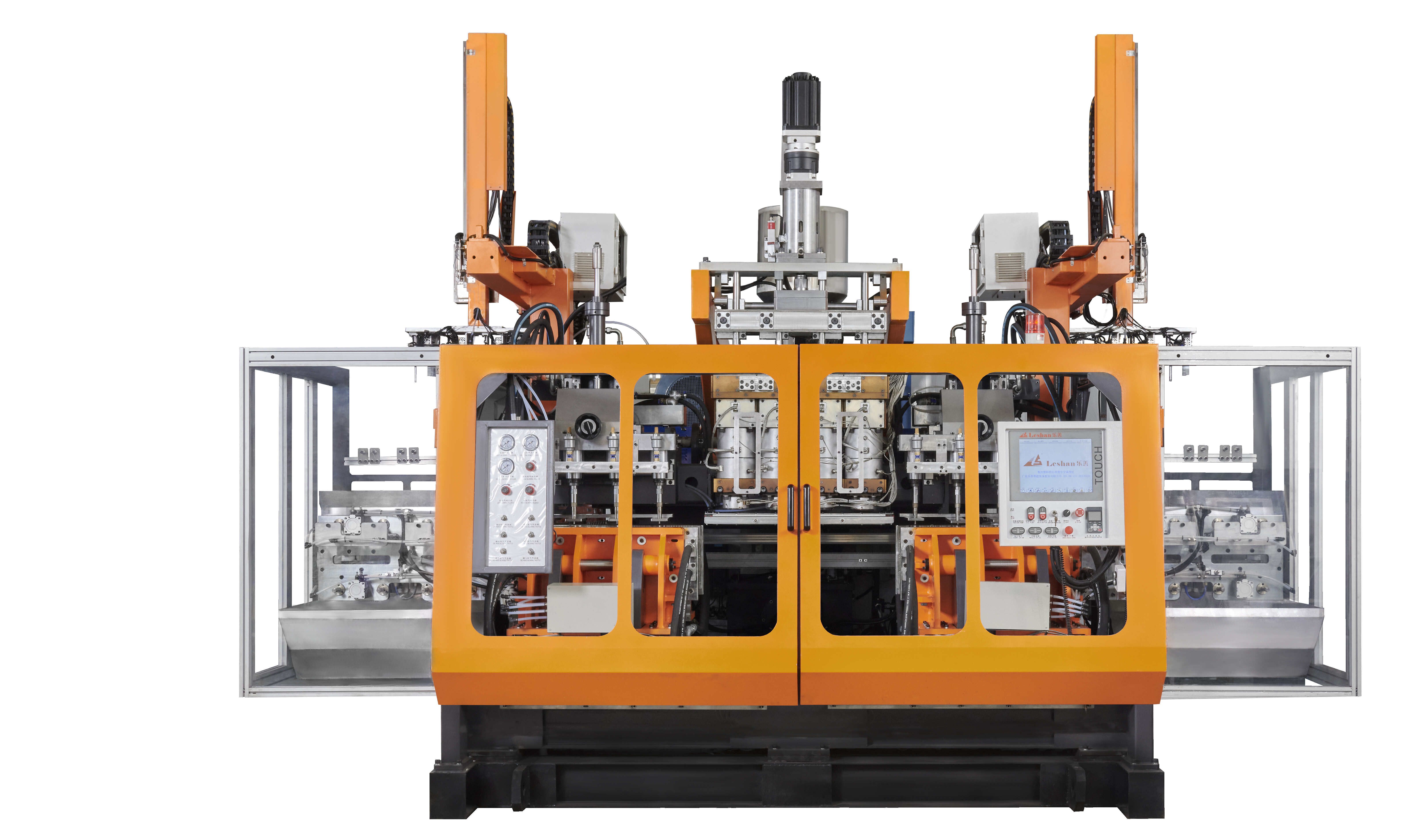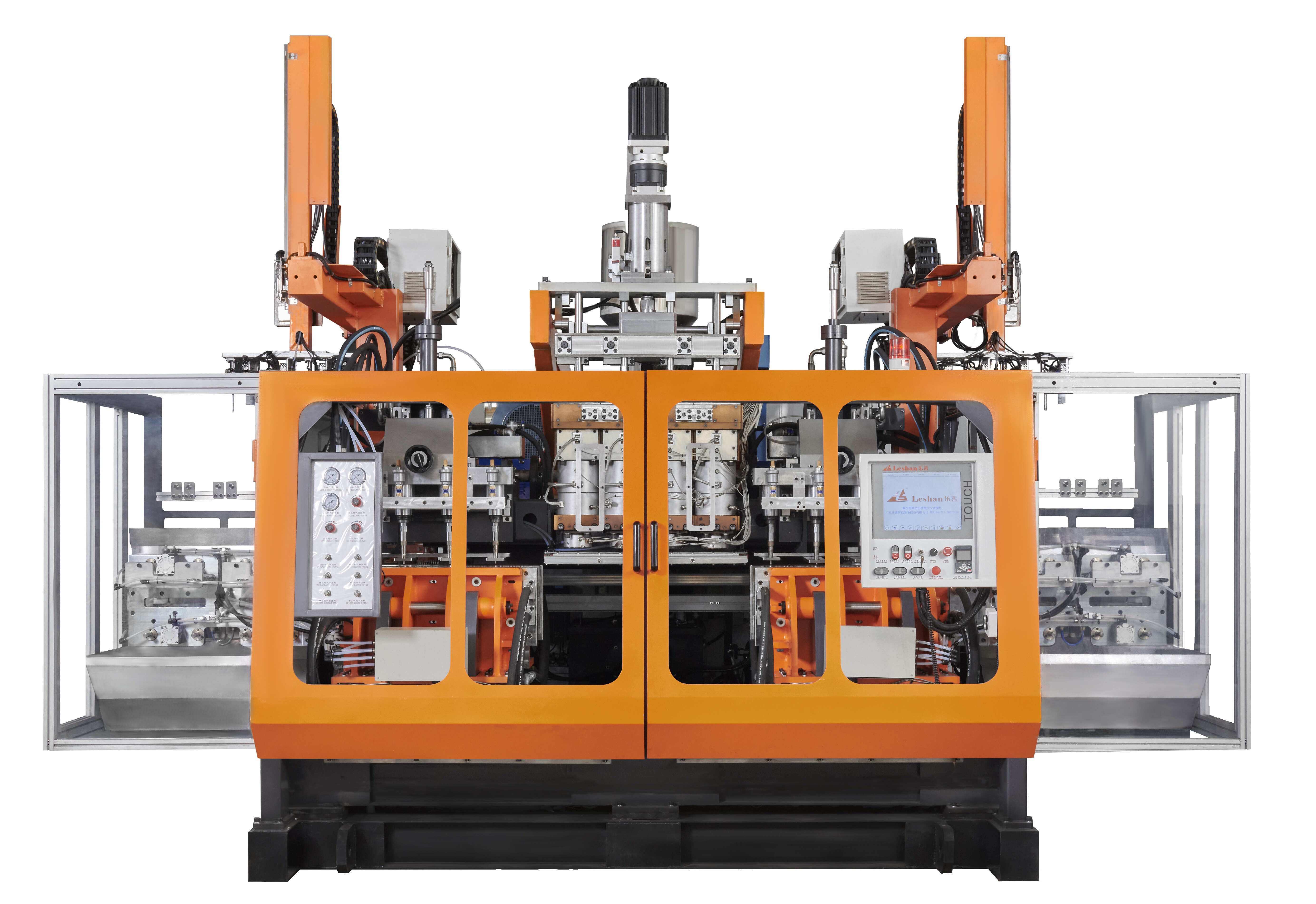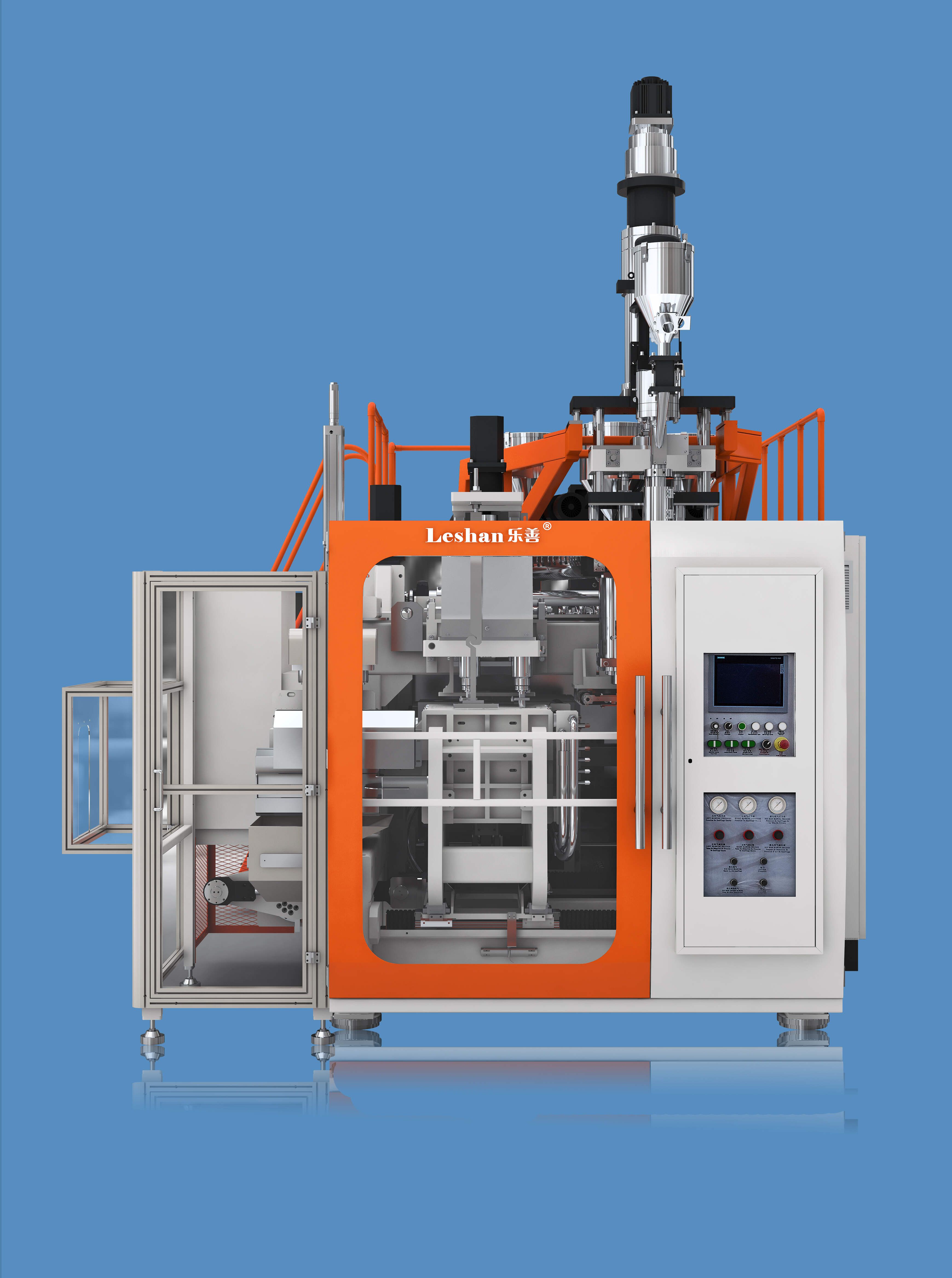
Extrusion Blow Molding Machines
Extrusion Blow Molding Machines
Leshan Intelligent Equipment Corp.,Ltd is a professional manufacturer of blow molding machines that integrates research and development, design, manufacturing, technical services, and marketing. The company is located in Foshan, Guangdong, adjacent to large and medium-sized cities such as Shenzhen, Guangzhou, and Dongguan. Our products include Food bottle blow molding machine,Blowing Mould & Injection Mould,Engine oil bottle blow molding machine,Extrusion Die Head,Auxiliary machine,PET Machine,Milk bottle blow molding machine,Cleaning bottle blow molding machine,Irregular shape product blow molding machine, etc.
The company's factory covers an area of over 10000 square meters and has over 300 technical and staff members. We are still adopting international standards and ISO9001:2012 quality management system in production. Therefore, the production quality, efficiency, energy consumption, and control maintenance of Leshan blow molding machines are among the top in the domestic industry, and their sales are far ahead of the domestic industry.
| Parameter | Information |
|---|---|
| Product Name | extrusion blow molding machines |
| Brand Name | Leshan |
| Place of Origin | Foshan,Guangdong,China |
| Plastic Processed | PA,EVA,PC,ABS,Polystyrene,HDPE,PP...etc |
| Air Pressure(MPa) | 0.8 MPa |
| Color | Customized Color |
| Delivery Time | 45 days |
| Port | ShunDe/GuangZhou/ShenZhen China |
| Export region | Africa,Asia,Europe |
| Export Country | Russia, Australia, Poland,Isle of Man,Reunion,Liechtenstein...etc |
| Application | Bottle |
| OEM/ODM | Yes |
| Core Components | Engine,Motor,Pump,Bearing,Gear...etc |
| Voltage | 380V |
| Service | Online support... |
| MOQ | 1 set |
| Certification | ISO9001,CE... |
| Supply Ability | 500 Set/Sets per Month |
| Weight (T) | 5-18(According to specific model) |
| Packaging Details | Standard exporting machine packing with plastic film |
| Lead time (days) | 70 (To be negotiated) |
Please note: The above table data is for reference only. For specific information, please contact us.

extrusion blow molding machines also offer flexibility and scalability. It can adjust the production process and parameters according to production needs to meet different product requirements. At the same time, the blow molding machine also has extension functions. By adding additional devices, it can realize bottle mouth separation, label attachment and other processing to meet the application needs of more fields.

extrusion blow molding machines---FAQs Guide
2.How to control temperature and pressure during the production process of extrusion blow molding machines?
3.How does the extrusion blow molding process differ from injection blow molding, and what types of products are typically produced using each method?
4.What is the difference between traditional extrusion blow molding machines and fully computer-controlled blow molding machines?
5.What are the main components of a extrusion blow molding machines?
6.How to control the energy consumption of extrusion blow molding machines?
7.How to design and customize extrusion blow molding machines?
8.How do extrusion blow molding machines manufacturers control variables like temperature, pressure, and blow time in the blow molding process to ensure consistent product quality?
9.What is the working principle of a blow molding machine?
10.What factors will affect the production efficiency of extrusion blow molding machines?
11.What are the safety standards for extrusion blow molding machines?
1.Besides the blow molding machine, what other services can Leshan provide?
Also provide close mold, auxiliary system, key engineering services.
2.How to control temperature and pressure during the production process of extrusion blow molding machines?
We focus on our customers' needs and strive to meet their expectations, so we take this very seriously.
1. Use a temperature controller: A temperature controller is an essential tool for controlling the temperature during the production process of blow molding machines. It allows you to set and maintain the desired temperature for the different stages of the process.
2. Monitor the temperature regularly: It is important to monitor the temperature of the machine regularly to ensure that it is within the desired range. This can be done using a thermometer or a temperature sensor.
3. Adjust the temperature settings: Depending on the type of material being used and the stage of the production process, the temperature settings may need to be adjusted. For example, a higher temperature may be required for melting the plastic, while a lower temperature may be needed for cooling the molded product.
4. Use a cooling system: To control the temperature during the cooling stage, a cooling system can be used. This can be in the form of a water chiller or a cooling tower, which helps to maintain a consistent temperature for the molded product.
5. Use a pressure regulator: A pressure regulator is used to control the pressure inside the machine. This is important for ensuring that the plastic is evenly distributed and that the final product has the desired shape and thickness.
6. Monitor the pressure: Just like temperature, it is important to monitor the pressure inside the machine regularly. This can be done using a pressure gauge or a pressure sensor.
7. Adjust the pressure settings: Depending on the type of material and the desired product, the pressure settings may need to be adjusted. This can be done manually or through the use of an automated pressure control system.
8. Use safety valves: Safety valves are important for maintaining the pressure within safe limits. They help to prevent any accidents or damage to the machine.
9. Train operators: It is important to train operators on how to control the temperature and pressure during the production process. They should be familiar with the different settings and know how to make adjustments when necessary.
10. Regular maintenance: Regular maintenance of the machine is crucial for ensuring that the temperature and pressure control systems are functioning properly. This will help to prevent any unexpected issues during the production process.
3.How does the extrusion blow molding process differ from injection blow molding, and what types of products are typically produced using each method?
We have been working hard to improve service quality and meet customer needs.
Extrusion blow molding and injection blow molding are two different processes used to manufacture plastic products. While both methods involve melting plastic and shaping it into a desired form, there are some key differences between the two.
Extrusion blow molding is a process in which a molten tube of plastic, called a parison, is extruded through a die and then inflated to form a hollow product. The parison is then cooled and the mold opens to release the finished product. This process is commonly used to produce bottles, containers, and other hollow objects.
On the other hand, injection blow molding involves injecting molten plastic into a mold cavity, where it is then cooled and solidified. The mold then opens to release the finished product. This process is commonly used to produce small, complex, and precise products such as medical devices, pharmaceutical packaging, and small bottles.
One of the main differences between the two processes is the way the plastic is shaped. In extrusion blow molding, the plastic is shaped by the inflation of the parison, while in injection blow molding, the plastic is shaped by the mold cavity.
Another difference is the type of molds used. In extrusion blow molding, the molds are typically made of two halves that come together to form the desired shape. In injection blow molding, the molds are usually made of a single piece that is opened and closed to release the product.
The type of plastic used also differs between the two processes. Extrusion blow molding is typically used for high-density polyethylene (HDPE) and polyethylene terephthalate (PET) plastics, while injection blow molding is commonly used for polypropylene (PP) and polyethylene (PE) plastics.
In terms of product applications, extrusion blow molding is commonly used for larger, more simple products such as bottles and containers, while injection blow molding is used for smaller, more complex products such as medical devices and pharmaceutical packaging.
In summary, extrusion blow molding and injection blow molding are two different processes used to manufacture plastic products. While both methods involve melting plastic and shaping it into a desired form, they differ in the way the plastic is shaped, the type of molds used, and the types of products produced.
4.What is the difference between traditional extrusion blow molding machines and fully computer-controlled blow molding machines?
We have the leading technology and innovation capabilities, and attach importance to employee training and development, and provide promotion opportunities.
Traditional blow molding machines are operated manually by a person, while fully computer-controlled blow molding machines are operated by a computer program. This means that traditional blow molding machines require more human labor and supervision, while fully computer-controlled machines can run automatically with minimal human intervention.
Additionally, traditional blow molding machines may have limited capabilities and may only be able to produce simple shapes, while fully computer-controlled machines can produce more complex and precise shapes. This is because the computer program can control the machine's movements and parameters with greater accuracy and consistency.
Furthermore, fully computer-controlled blow molding machines often have advanced features such as real-time monitoring, data collection, and automatic adjustments, which can improve efficiency and quality control.
Overall, the main difference between traditional blow molding machines and fully computer-controlled machines is the level of automation and precision in the production process.

5.What are the main components of a extrusion blow molding machines?
We have rich industry experience and professional knowledge, and have strong competitiveness in the market.
1. Extruder: This is the main component of a blow molding machine, which melts and forms the plastic material into a parison (hollow tube).
2. Die Head: The die head is responsible for shaping the parison into the desired shape and size.
3. Clamping Unit: The clamping unit holds the mold in place and provides the necessary pressure for the blowing process.
4. Blow Pin: The blow pin is used to inflate the parison and shape it against the mold.
5. Cooling System: The cooling system helps to cool down the plastic material and solidify it into the desired shape.
6. Control System: The control system is responsible for controlling and monitoring the various parameters of the blow molding process, such as temperature, pressure, and speed.
7. Mold: The mold is the cavity into which the plastic material is blown and takes the shape of the final product.
8. Ejector: The ejector removes the finished product from the mold after the blowing process is complete.
9. Hydraulic System: The hydraulic system provides the necessary power and pressure for the various movements of the machine.
10. Electrical System: The electrical system controls the various motors and sensors of the machine.
11. Air Compressor: The air compressor supplies the compressed air needed for the blowing process.
12. Chiller: The chiller is used to cool down the extruder and other components of the machine to maintain the required temperature.
13. Conveyor System: The conveyor system moves the finished products out of the machine for further processing or packaging.
6.How to control the energy consumption of extrusion blow molding machines?
We are a professional extrusion blow molding machines company dedicated to providing high quality products and services.
1. Use energy-efficient machines: When purchasing blow molding machines, opt for models that are energy-efficient and have a high energy star rating. These machines are designed to consume less energy while still maintaining high production efficiency.
2. Regular maintenance: Regular maintenance of the machines is crucial in controlling energy consumption. This includes cleaning and lubricating the machines, checking for leaks, and replacing worn-out parts. A well-maintained machine will operate more efficiently and consume less energy.
3. Optimize production processes: Analyze the production processes and identify areas where energy consumption can be reduced. For example, reducing the amount of air pressure used in the blowing process can significantly reduce energy consumption.
4. Use energy-saving features: Many blow molding machines come with energy-saving features such as automatic shut-off, idle mode, and variable speed drives. These features can help reduce energy consumption when the machine is not in use or operating at a lower speed.
5. Monitor energy usage: Install energy meters to monitor the energy consumption of the machines. This will help identify areas where energy is being wasted and allow for adjustments to be made to reduce consumption.
6. Use energy-efficient materials: The type of material used in the blow molding process can also affect energy consumption. Opt for materials that require less energy to heat and mold, such as lightweight plastics.
7. Implement energy management systems: Consider implementing an energy management system that can track and analyze energy usage in real-time. This will help identify patterns and areas for improvement.
8. Train employees: Proper training of employees on the operation and maintenance of the machines can help reduce energy consumption. They should be aware of energy-saving practices and encouraged to follow them.
9. Turn off machines when not in use: Make it a practice to turn off the machines when they are not in use, such as during breaks or at the end of the day. This will help save energy and reduce unnecessary wear and tear on the machines.
10. Regularly review and update energy-saving strategies: Regularly review and update your energy-saving strategies to ensure they are still effective. As technology advances, new energy-saving techniques may become available, so it is essential to stay informed and make necessary changes.
7.How to design and customize extrusion blow molding machines?
We actively participate in the extrusion blow molding machines industry associations and organization activities. The corporate social responsibility performed well, and the focus of brand building and promotion
Designing and customizing blow molding machines involves several steps and considerations. Here are some steps to follow:
1. Identify the type of blow molding machine needed: There are different types of blow molding machines, such as extrusion blow molding, injection blow molding, and stretch blow molding. Each type has its own unique features and capabilities, so it is important to determine the specific type of machine needed for the desired application.
2. Determine the production requirements: The production requirements, such as the desired output, bottle size and shape, and material type, will help determine the specifications and features of the machine.
3. Select the appropriate components: The components of a blow molding machine include the extruder, mold, clamping system, and control system. Each component should be carefully selected based on the production requirements and the type of machine.
4. Consider the material and design of the mold: The mold is a crucial component of a blow molding machine as it determines the shape and size of the final product. The material and design of the mold should be chosen based on the type of material being used and the desired product specifications.
5. Customize the control system: The control system is responsible for the operation and monitoring of the machine. It should be customized to meet the specific production requirements and to ensure efficient and safe operation.
6. Incorporate safety features: Safety should be a top priority when designing and customizing blow molding machines. Safety features such as emergency stop buttons, safety guards, and sensors should be incorporated into the design to prevent accidents and ensure the safety of operators.
7. Test and optimize the machine: Once the machine is designed and assembled, it should be thoroughly tested to ensure it meets the production requirements and operates efficiently. Any necessary adjustments or optimizations should be made before the machine is put into full production.
8. Provide training and support: It is important to provide training and support to operators and maintenance personnel to ensure they are familiar with the machine and can operate and maintain it properly.
In addition to these steps, it is important to work closely with a reputable manufacturer or supplier who has experience in designing and customizing blow molding machines. They can provide valuable insights and expertise to help create a machine that meets your specific needs and requirements.
8.How do extrusion blow molding machines manufacturers control variables like temperature, pressure, and blow time in the blow molding process to ensure consistent product quality?
We pay attention to the transformation of intellectual property protection and innovation achievements. Your OEM or ODM order design we have a complete confidentiality system.
1. Temperature Control: Blow molding machines have heating elements that are used to heat the plastic material to a specific temperature before it is blown into the mold. The temperature is controlled by sensors and thermostats that monitor and adjust the temperature as needed. This ensures that the plastic material is at the optimal temperature for the blow molding process, which helps to produce consistent product quality.
2. Pressure Control: The pressure in the blow molding process is controlled by the air pressure in the mold. The blow molding machine has a pressure regulator that controls the amount of air that is blown into the mold. This pressure is monitored and adjusted to ensure that it is consistent throughout the molding process. This helps to ensure that the plastic material is evenly distributed and that the final product has consistent wall thickness.
3. Blow Time Control: The blow time refers to the amount of time that the air is blown into the mold to inflate the plastic material. This is a critical variable in the blow molding process as it determines the final shape and size of the product. Blow molding machines have timers that control the duration of the blow time, and these can be adjusted to ensure consistent product quality.
4. Process Monitoring: Blow molding machine manufacturers also use advanced process monitoring systems to track and control the variables in the blow molding process. These systems use sensors and software to monitor and adjust the temperature, pressure, and blow time in real-time. This helps to ensure that any variations in these variables are immediately detected and corrected, resulting in consistent product quality.
5. Quality Control: In addition to controlling the variables during the blow molding process, manufacturers also have quality control measures in place to ensure consistent product quality. This includes regular testing and inspection of the final products to check for any defects or variations. Any issues are identified and addressed to maintain the desired level of product quality.

9.What is the working principle of a blow molding machine?
We focus on innovation and continuous improvement to maintain a competitive advantage.
The working principle of a blow molding machine involves the use of compressed air to inflate a molten plastic tube or parison inside a mold cavity. This creates a hollow shape that is then cooled and solidified to form a plastic product.
The process begins with the plastic material, usually in the form of pellets, being fed into a hopper and then melted in an extruder. The molten plastic is then forced into a long tube or parison, which is then clamped between two halves of a mold.
Next, a nozzle is inserted into the parison and compressed air is blown into it, causing the plastic to expand and take the shape of the mold cavity. The mold is cooled to solidify the plastic, and then the mold halves are separated, and the finished product is ejected.
The blow molding process can be either extrusion blow molding or injection blow molding, depending on the type of machine used. In extrusion blow molding, the parison is formed by extruding the molten plastic through a die, while in injection blow molding, the parison is formed by injecting the molten plastic into a mold cavity.
The working principle of a blow molding machine is based on the principles of thermodynamics and fluid mechanics, where the expansion of compressed air inside the parison creates pressure that forces the plastic to take the shape of the mold. This process allows for the production of hollow plastic products with complex shapes and sizes.
10.What factors will affect the production efficiency of extrusion blow molding machines?
We have a professional team that is committed to the innovation and development of extrusion blow molding machines.
1. Machine Design and Technology: The design and technology of the blow molding machine play a crucial role in its production efficiency. A well-designed machine with advanced technology can produce more products in less time.
2. Type of Material: The type of material used for blow molding can significantly affect the production efficiency. Some materials, such as HDPE, are easier to process and can result in higher production rates compared to others.
3. Mold Design and Quality: The design and quality of the mold used in the blow molding process can also impact production efficiency. A well-designed and high-quality mold can produce more consistent and precise products, resulting in higher production rates.
4. Machine Maintenance: Regular maintenance of the blow molding machine is essential to ensure its optimal performance. Neglecting maintenance can lead to breakdowns and downtime, reducing production efficiency.
5. Operator Skill and Training: The skill and training of the machine operator can also affect production efficiency. A trained and experienced operator can operate the machine more efficiently, resulting in higher production rates.
6. Production Volume and Batch Size: The production volume and batch size can also impact the production efficiency of blow molding machines. Larger production volumes and batch sizes can result in higher efficiency due to reduced setup and changeover times.
7. Ambient Conditions: The ambient conditions, such as temperature and humidity, can affect the production efficiency of blow molding machines. Extreme temperatures or high humidity can affect the quality of the products and slow down the production process.
8. Automation and Control Systems: The level of automation and control systems used in the blow molding machine can also impact production efficiency. Advanced automation and control systems can improve process control and reduce human error, resulting in higher production rates.
9. Energy Efficiency: The energy efficiency of the blow molding machine can also affect its production efficiency. Energy-efficient machines can reduce operating costs and increase production rates.
10. Quality Control: The implementation of a robust quality control system can also improve production efficiency. By identifying and addressing defects early on, the machine can produce more high-quality products in less time.
11.What are the safety standards for extrusion blow molding machines?
We are a new extrusion blow molding machines manufacturer.
1. Electrical Safety: Blow molding machines should comply with all relevant electrical safety standards, such as the National Electrical Code (NEC) and the International Electrotechnical Commission (IEC) standards.
2. Machine Guarding: All moving parts of the machine should be guarded to prevent accidental contact and injuries. The guards should be securely fixed and not easily removable.
3. Emergency Stop: The machine should have an easily accessible emergency stop button that can quickly shut down the machine in case of an emergency.
4. Lockout/Tagout: The machine should have a lockout/tagout system in place to prevent accidental start-up during maintenance or repair.
5. Pressure Relief: Blow molding machines use high-pressure air to mold plastic, so they should have a pressure relief system in place to prevent over-pressurization and potential explosions.
6. Material Handling: The machine should have a safe and efficient material handling system to prevent injuries and accidents during the loading and unloading of materials.
7. Noise Control: Blow molding machines can produce high levels of noise, so they should have noise control measures in place to protect workers' hearing.
8. Fire Safety: The machine should have fire safety measures in place, such as fire extinguishers and fire alarms, to prevent and control fires.
9. Operator Training: All operators should receive proper training on how to operate the machine safely and be aware of potential hazards.
10. Regular Maintenance: The machine should undergo regular maintenance and inspections to ensure it is in good working condition and meets all safety standards.
Tags: 220l drum blow molding machine
